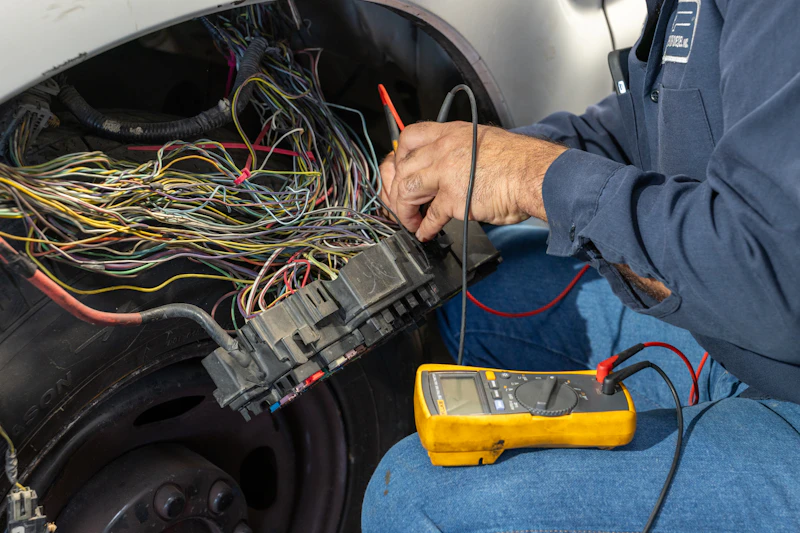Heavy-Duty Electrical Diagnostics: Save Time, Money, and Downtime
Don’t let electrical gremlins sideline your rig. Make electrical system checks part of your regular maintenance routine, and work with techs who diagnose before they replace.

When a heavy-duty truck's electrical system starts acting up, it can feel like finding a needle in a haystack. A dim headlight here, a slow crank there—before you know it, you’re losing hours, maybe days, chasing the problem. Electrical issues can bring your rig to a screeching halt, and in California’s high-demand freight lanes, downtime is money lost. That’s where smart, heavy-duty electrical diagnostics come into play. The goal? Zero guesswork, faster fixes, and a fatter bottom line.
Why Electrical Diagnostics Matter
Your truck’s electrical system isn’t just about lights and horns—it’s the nerve center that keeps your engine, after-treatment systems, and safety equipment running. Modern rigs have countless sensors, relays, and computers (ECMs) working together. One glitch in the wiring harness, and you can see fault codes popping up like popcorn.
Without a clear diagnostic strategy, techs end up swapping out parts in the dark, which is expensive and inefficient. A precise diagnostic process cuts straight to the culprit—whether it’s a failing alternator, a corroded ground, or a misfiring sensor.
Core Components of Your Electrical System
Before we get into the nuts and bolts of troubleshooting, let’s run through the big players in your truck’s electrical lineup:
- Battery – Supplies the power to crank the starter, fire up glow plugs, and get fuel injectors spraying during start-up.
- Alternator – Keeps your battery charged and your electrical systems alive while the engine runs. If it fails, you’re running on borrowed time before the battery dies.
- Starter Motor – Spins the crankshaft fast enough to start the engine’s combustion cycle.
- Wiring & Connectors – The veins and arteries of your electrical system, moving current where it’s needed.
- Fuses & Relays – Protect circuits from overload and control high-power components.
- Sensors & Modules – From coolant temperature sensors to ECMs, these keep your systems in tune and compliant with emissions regulations.
Signs Your Truck Needs Electrical Attention
Heavy-duty electrical issues rarely appear out of nowhere—they often leave breadcrumbs:
- Slow cranking or no crank at all
- Warning lights on the dash (especially battery or check engine lights)
- Dimming headlights when accessories are in use
- Intermittent system failures—like wipers or fans cutting out unexpectedly
- Repeated blown fuses
- Diagnostic Trouble Codes (DTCs) piling up on your ECM scan
Ignoring these signs risks getting stranded roadside or damaging costly systems like your after-treatment components.
Smart Diagnostic Steps to Save Time and Money
Here’s a streamlined approach techs use to avoid wasting labor hours and unnecessary part swaps:
1. Start with the Battery and Charging System
Check battery voltage at rest and under load. Then verify the alternator’s output—both at idle and under electrical load. Poor alternator performance is a major cause of repeat electrical issues.
2. Inspect Grounds and Connections
California’s salty coastal air and high humidity can accelerate corrosion. A bad ground can mimic sensor failure, causing hours of chasing phantom problems.
3. Pull Fault Codes
Connect a diagnostic scan tool to read DTCs. Modern trucks store rich data in the ECM—leverage it before touching a wrench.
4. Load-Test Circuits
For components like starter motors or heater blowers, simulate real operating loads. Voltage drops under load often reveal hidden resistance in wiring.
5. Follow the Wiring Diagram
Skipping the wiring diagram is like trying to navigate Los Angeles without GPS. Know the path the current takes before opening up panels.
Preventive Electrical Maintenance: The Downtime Killer
Staying ahead of electrical problems is where the real savings happen. Here are preventive practices every California fleet should adopt:
- Monthly battery inspections – Look for swelling, cracks, or corrosion.
- Quarterly alternator output checks – Especially before long hauls.
- Seasonal wiring harness inspections – Replace damaged loom and secure loose runs.
- Clean ground straps – A wire brush and dielectric grease go a long way.
- Update ECM software – Patches often fix glitchy sensor readings.
How Electrical Diagnostics Reduce Downtime
When electrical diagnostics are done right:
- Repairs are faster – No guessing, just targeted fixes.
- Parts costs drop – Only the failed component gets replaced.
- Breakdowns are rarer – Preventive catches problems before they escalate.
- Compliance stays intact – Faulty sensors can trigger after-treatment system shutdowns; fixing them quickly avoids violations.
California-Specific Considerations
The Golden State’s tough emissions standards mean trucks rely heavily on sensors and control modules. An unresolved electrical glitch can:
- Trigger derate modes, cutting power until repairs are made.
- Delay deliveries due to mandatory shop visits.
- Rack up hefty fines for non-compliance.
That’s why electrical diagnostics aren’t just about keeping you rolling—they’re about keeping you legal.
Keep Moving with Electrical Diagnostics Done Right
Electrical problems in heavy-duty trucks are like hidden potholes on I-5—ignore them, and you’ll pay for it. A disciplined electrical diagnostic process gets your truck back on the road faster, saves you money on parts and labor, and minimizes costly downtime. Whether you’re hauling produce out of the Central Valley or freight into the Port of Long Beach, reliable diagnostics keep you moving.

